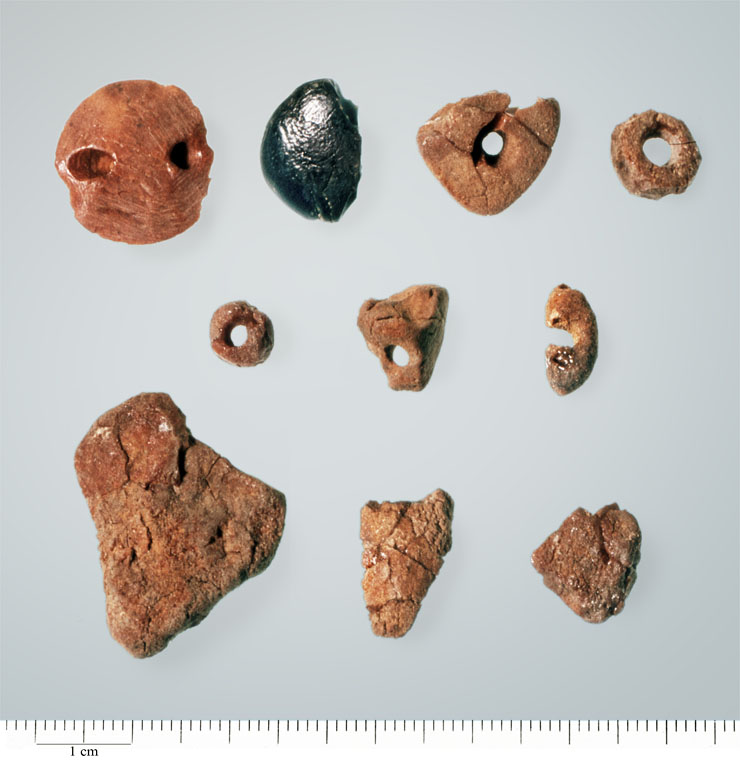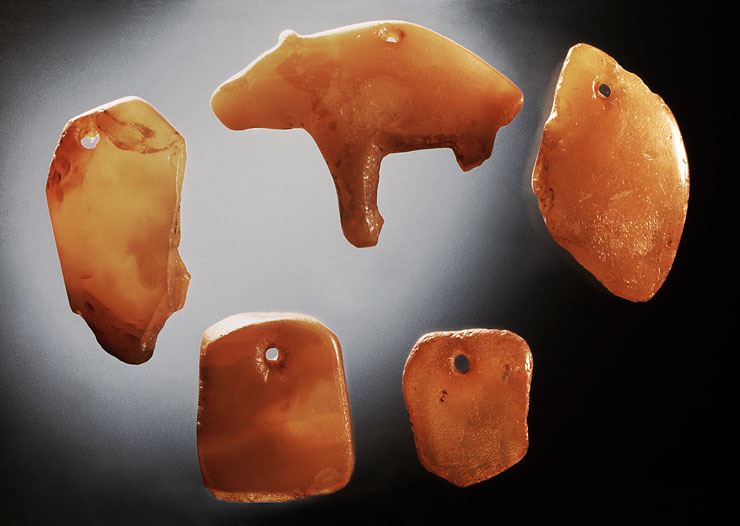
Polished amber has a shiny, transparent, golden appearance. Amber is petrified resin from pine trees of the species Pinus succinifera, which means “resin-bearing pine”. This pine species flourished about 35–55 million years ago. In Northern Europe, we find amber in certain types of soil, especially in the so-called blue soil in the furthest south-east reaches of the Baltic Sea, in Lithuania and Prussia, and on the beaches of the North Sea coast of Denmark.
The amber that was used in prehistoric times must have been brought to Norway by people, perhaps as valuable gifts to relatives, friends or allies. Amber was by no means an ordinary commodity in those days. Much of it probably arrived as finished jewellery – as round and oval-shaped pearls and pendants in various forms, both as individual objects and as entire necklaces – but amber may also have been brought here as larger pieces that were further refined in Norway.
All in all, a couple of hundred pieces of Stone Age amber have been found here in Norway. Stone Age amber has been found in graves, in rubbish dumps at human settlements and in stray finds. Most of the finds of amber in Norway have been in the Jæren district, and there have also been more scattered finds from the rest of Western Norway north to the coast of Trøndelag. Amber objects have also been found in Northern Norway. Beautiful, well-preserved objects of Stone Age amber have been found all the way up to the isle of Melkøya near Hammerfest in Finnmark County. Many finds have been made by chance, but some have been discovered in archaeological excavations. During these excavations, the amber is not always so easy to recognize and can often be easily mistaken for clumps of sand. The beautiful quality of refined amber does not become apparent until it has been cleaned and polished.
In contrast to our neighbouring countries, Sweden and Denmark, Stone Age graves are quite rare in Norway. One of the few grave finds with amber turned up in a grave chamber built with large stone slabs, a dolmen, at Holtnes in Hurum municipality in Buskerud County. This dolmen is dated at about 3630–3350 BC. The amber objects had been part of a necklace consisting of various pieces of amber. This type of necklace has been found in Denmark and Northern Germany, but in a Norwegian context this find is completely unique.

No fewer than 70 amber objects from the Middle Neolithic period have been found in a large settlement at Auve on the peninsula of Vesterøya in the municipality of Sandefjord in Vestfold County, dated to about 3200–2500 BCE. These objects were found in what was probably a Stone Age rubbish dump. This shows that although we rarely find amber in Stone Age locations, amber may have been relatively widespread in certain communities and contexts. Some of these items appear to be scraps discarded after production while others appear to be somewhat larger unrefined pieces of amber. Thus, the amber finds from Auve show that amber was refined in Norway and not just imported as finished objects. Another indication of local production is rather distinctive, lenticular “buttons” with V-shaped holes for sewing them onto a piece of clothing – perhaps at least as much for ornamentation as for practical use. These buttons have been found in many places in Norway, e.g. at Auve and several places in Western Norway. The buttons appear to be especially common in Norway, so we may be looking here at the evolution of local production.
One of the finest and rarest amber objects from Norway was found in Åfjord municipality in Sør-Trøndelag County, where the amber was given the form of a glittering golden bear. This amber bear is currently on display at the Museum of Science in Trondheim.

Stone Age people also created jewellery from other materials besides amber. Jewellery made from animal teeth must have been widespread, though these have rarely been preserved. Stone was also used as a material for jewellery, especially slate, which can be easily shaped into forms well-suited to simple pendants. Otherwise, only our imagination sets the limits for what may have been used in the way of feathers, fur and other organic materials for the embellishment of clothing and the body.
The dating of the amber objects can be problematic, especially when the items have been found by chance in what archaeologists call “stray finds”. In such cases, the objects can only be dated by comparing them with other objects from dated contexts. At archaeological excavations, we can usually date the location where the amber and other prehistoric objects have been found by using radiological dating (the Carbon 14 method) or dating through finds of other, better known types of objects.
The amber in Norway was especially popular in the Neolithic period between the 4th and 3rd millennium BCE. A few objects may be even older, and some may be a little more recent. That means that they came to Norway at a time when agriculture had just barely begun to gain a foothold in this country. Like agriculture, the amber was also something that came here through connections with people from more southerly regions where these things already existed. Many other types of objects were brought here in the same way, such as painstakingly made moulds for axes and daggers of flint and other stones. Handicraft traditions also came from the South during this period, such as the art of creating pottery, spinning fibres into thread and maybe also the production of textiles onto which the amber objects were sewn.
References
Jensen, Jørgen 1982: Nordens guld. En bog om oldtidens rav, mennesker og myter. Gyldendalske Boghandel, Nordisk Forlag A/S, Copenhagen.
Østmo, Einar 1985: En dysse på Holtenes i Hurum. Nytt lys over østnorsk traktbegerkultur. Viking. Bind XLVIII. 1984. pp. 70-82.
Østmo, Einar 2007: The Northern Periphery of the TRB. Graves and Ritual Deposits in Norway. Acta Archaeologica. Vol. 78, nr. 2. pp. 111-142.
Østmo, Einar 2008: Auve. En fangstboplass fra yngre steinalder på Vesterøya i Sandefjord. I. Den arkeologiske del. Norske Oldfunn XXVIII. Kulturhistorisk museum, Universitetet i Oslo. Oslo.
Østmo, Einar 2015: Steinalderrav i Sør-Norge. I Marianne Vedeler og Ingunn Marie Røstad (red.): Smykker. Personlig pynt i kulturhistorisk lys. Museumsforlaget. Trondheim. pp. 113-131.